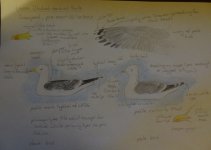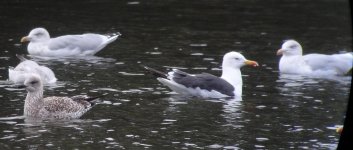Samuel Perfect
Well-known member
Saw these two LBBGulls on Swanpool (Falmouth, Cornwall) yesterday and was rather baffled at the huge variation in the two individuals (particularly their build and shading of the mantle).
The darker individual was classic LBBG shape and size whilst the paler bird was approaching Herring Gull proportions and far less slender in appearance.
My camera was playing up so I only managed a brief shot of the darker individual (none of the paler bird and no open wing view of the darker one).
All notes are on the drawing itself but please let me know if some of it is illegible.
Question is, are they both within reasonable variation for LBBGull?
Thanks :t:
The darker individual was classic LBBG shape and size whilst the paler bird was approaching Herring Gull proportions and far less slender in appearance.
My camera was playing up so I only managed a brief shot of the darker individual (none of the paler bird and no open wing view of the darker one).
All notes are on the drawing itself but please let me know if some of it is illegible.
Question is, are they both within reasonable variation for LBBGull?
Thanks :t:






